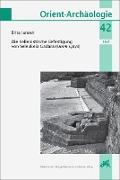- Start
- Die hellenistische Befestigung von Seleukeia Gadara (Umm Qays) 2 Bde
Die hellenistische Befestigung von Seleukeia Gadara (Umm Qays) 2 Bde
Angebote / Angebote:
Der bereits 1806 als Dekapolisstadt Gadara identifzierte Siedlungshügel von Umm Qays in exponierter Lage in NW-Jordanien mit Blick auf den See Genezareth wird seit 1959 untersucht. Der dritte Band nach dem spätrömischen Bogenmonument [OrA 21] und den Forschungen 1987-2000 [OrA 28] präsentiert den architektonischen und archäologischen Befund, die strategisch-militärische Bedeutung und die konstruktiven Finessen der kleinen seleukidischen Zitadelle. Sie ist sicher datiert [1. H. 2. Jh. v.Chr.] und im O- und S-Teil gut erhalten, während wichtige Stadtteile unbefestigt blieben. Eine bronzezeitliche und eisenzeitliche Vorgängeranlage in Tall Zira'a ist archäologisch, eine ptolemäische vor 200 v.Chr. nur historisch bezeugt. Anfang des 1. Jh. fiel die Festung zweimal an die Hasmonäer, wurde von Seleukiden bzw. Römern erneuert, aber schließlich unter bis zu 7 m Erde und Schutt begraben. Das qualitätvolle isodome und pseudoisodome Quadermauerwerk aus lokalem Kalkstein ist mittels Anathyrose und Gipsmörtel fugenlos gesetzt. Türme und Sockel sind massiv, aufgehende Mauern mit Füllmauerwerk. Die Tore und recht- und 5-eckigen Türme besitzen seleukidische und ptolemäische Merkmale.
The settlement hill of Umm Qays in an exposed location of NW-Jordan with a view of the Sea of Galilee was identified as the decapolis city of Gadara as early as 1806 and has been excavated since 1959. This 3rd volume after the Late Roman arch [OrA 21] and research 1987-2000 [OrA 28] features the architectural and archaeological evidence, the strategic and military significance and the constructive subtleties of the small Seleucid citadel. It is firmly dated [1st half 2nd century B.C.] and well preserved in the east and south, while important city quarters remained unfortified. Its BA and IA predecessor at Tall Zira'a is attested archaeologically, a Ptolemaic fortress only by written sources. In the early 1st century the fortress was taken twice by Hasmoneans, restored by Seleucids and Romans respectively, but eventually covered by up to 7 m of soil and debris. The high-quality ashlar masonry in opus isodomum and pseudoisodomum consisted of local limestone and was virtually jointlessly laid by means of anathyrosis and gypsum mortar. Towers and pedestral are solid, upright walls with a core of plain stonework. Gates and rectangular and pentagonal towers integrate both Seleucid and Ptolemaic characteristics.
Libri-Titel folgt in ca. 2 Arbeitstagen


